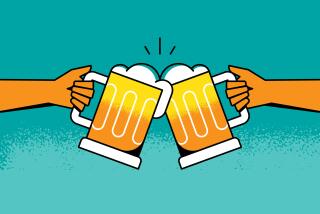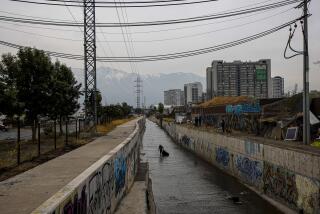Santiago: A Mere Hour From The Slopes
- Share via
SANTIAGO, Chile — For first-time travelers to South America, Santiago, wedged between desert and mountain in a valley dotted with vineyards, is like a dip in a lukewarm pool--refreshing but not shocking. This is a soothing city, affordable and easy to get around in. And Chilean hospitality, renowned across the continent, lives up to its reputation.
U.S. skiers trying out any of Chile’s best known slopes are less than 90 minutes from its urban delights. People are friendly and casual, shopping bargains abound, meals are accompanied by some of the continent’s finest wine, and cultural attractions are many in the native land of two Nobel prize-winning poets, Pablo Neruda and Gabriela Mistral.
Most people visit Santiago during its warm months from December to March. But the intense summer heat--hovering in the 90s for days--is too warm for some visitors and sends even residents fleeing into its many parks and pedestrian malls. Temperatures in the winter months, June through September, can drop to near freezing at night and daytime drizzle is common, but travelers with slickers or overcoats can explore the city comfortably.
“The advantage of Chile in the winter is that there are a lot of activities. . . ballet, theater, opera, just about anything you can imagine in a developed cultural center,” said Marilyn Pugh, tour manager for LanChile Airlines.
Santiago’s main square, the Plaza de Armas, is where the city was founded 449 years ago by ragged Spanish conquistador Pedro de Valdivia. The plaza was used for public floggings and hangings in colonial days, but now it’s inhabited by shoeshine boys, vagrants, strolling couples and youngsters kicking soccer balls.
The square is bordered by Sanitago’s fourth cathedral--earthquakes and fires destroyed the first three on the site--with its religious art museum, the pink post office building used as Chile’s first presidential palace and the National Historical Museum, whose documents, furnishings and paintings trace the country’s struggle for independence.
Tucked under the arches off the plaza is popular Chez Henry, a three-in-one stop with a delicatessan-wine shop, restaurant and nightclub. The deli clerks offer good advice on Chilean wines and the restaurant, crowded around the clock, specializes in Italian pastas and such Chilean dishes as pastel de choclo, a rich corn and meat casserole.
Two blocks away on Merced Street is an art collection that links Chile with its most unusual possession--Easter Island, 2,300 miles away in the Pacific Ocean. The Merced Church museum has wood carvings, ceramics and other artifacts from this volcanic island, whose famous huge stone statues, called moai, have fascinated archaeologists ever since they were discovered. (One moai has been transported to the grassy promenade of Avenida Libertador O’Higgins.)
The church museum also offers a crash course in Latin America’s violently graphic, colonial religious art, including bloody statues covered by crystal bell jars. The bell jars, survivors of an ocean journey from Europe and Santiago’s frequent earthquakes, originally displayed erotic objects--which religious Santiaguinos, as city residents are known, replaced with Christian images.
Downtown Santiago is cut by two pedestrian malls where bankers in dark suits and window shoppers with children in tow cross paths. The malls, Paseo Ahumada and Paseo Huerfanos, are lined with banks, currency exchange offices, travel agencies, airlines, shoe stores (great buys on leather), boutiques and pastry shops.
On Ahumada, the pungent smell of coffee is a tantalizing sign that Cafe Haiti or Cafe Caribe--the city’s trendiest daytime stops--are near. Chile produces no coffee, making the real stuff a luxury. What most restaurants serve is instant Nescafe. At these stand-up counters, thick strong coffee is served by women outfitted in exotic jungle prints. Executives hash out business deals over cafe con leche (coffee with milk) .
Ahumada’s landmark is Falabella, Santiago’s biggest department store, just two blocks from the Plaza de la Libertad, or Liberty Square. The plaza, sided by the imposing Palacio de la Moneda, has become a symbol of modern Chile’s darkest days.
Built as the Spanish royal mint and decried for its size and exorbitant cost, the austere structure serves as Chile’s equivalent of the White House.
In 1973, during the democratic country’s only military coup, President Salvador Allende was killed inside La Moneda by military forces under Gen. Augusto Pinochet.
When foreign journalists entered La Moneda earlier this year, for the first time in 16 years, they saw the bunker built secretly during Pinochet’s reign. Now, with the military dictatorship gone and President Patricio Alywin installed by democratic vote, the carbine-carrying police are no longer intimidating. Chile’s economy is stable and there is a relatively low crime rate.
To the side of La Moneda is the Carrera Hotel, headquarters for journalists who covered the coup and still one of Santiago’s most elegant hotels.
From the Carrera’s front door--or the plaza itself--visitors can watch the midday changing of the guard at La Moneda. Circling the plaza are a number of international banks, the signposts of a country that has consistently boasted foreign investment while its neighbors fought roller coaster fluctuations in inflation, prices and salaries.
The best site for an overview of the city is the Cerro San Cristobal, a hilltop park crowned by a massive statue of the Virgin Mary, her arms outstretched over Santiago. When the smog (which exceeded pollution levels of Los Angeles and Mexico City in 1989) is light, one can see the city--the Andes peaks to the east and the slopes of the coastal mountains to the west.
Cerro San Cristobal’s park, with a zoo, botanical gardens, two swimming pools, picnic grounds and hiking paths is one of South America’s finest. It can be reached by car, cab or funicular railway. Once in the park, a skylift takes visitors up the 1,145-foot hill to the Enoteca.
A whitewashed neocolonial building tucked behind a grove of palm trees, the Enoteca houses a wine museum, wine-tasting salon and is one of the city’s best restaurants.
At dinner, there’s a show of traditional Chilean music and dance. Enoteca manager, Max Rodriguez, speaks English and is happy to suggest world-class wines to accompany meals or to take home. The best-known labels are Concha y Toro, Cousino Macul, Santa Carolina and Undurraga. The finest reserves come from the Maipo valley just outside Santiago.
At the base of Cerro San Cristobal is Bellavista, the city’s Bohemian district where artists, writers and poets huddle together over inexpensive seafood meals and musicians share bottles of wine, conversing in the smoky bistros dotting the neighborhood.
Bellavista is almost clogged with shops specializing in the copper and lapis lazuli items for which Chile is famous. The bright blue gemstones are incorporated into everything from necklaces to silverware. More lapis lazuli is found a few blocks east in the government-run CEMA store at Avenida Portugal 351 in the Providencia neighborhood.
Set up to sell the handicrafts of young mothers, the nationwide CEMA stores offer Chile’s biggest and best variety of handiwork.
Once a rural area, Providencia is a posh shopping district named for the Sisters of Providence and the huge adobe convent they opened in 1853. This is the stomping ground of Santiago’s rich, a neighborhood of exclusive boutiques, intimate European-style hotels, chic restaurants and Mercedes-Benzes--although the latter spend more time in their carports now, thanks to a strict new anti-pollution law that imposes a revolving ban on cars one day a week, depending on the final numbers on their license plates.
Many of these wealthy residents are the descendants of Chile’s wine and mine magnates. A microcosm view of that opulence is seen at Palacio Cousino, a neoclassical mansion built in 1878 as a private home where visiting royalty could stay while in Santiago.
Although a fire sparked by a short circuit botched plans for British Queen Elizabeth’s overnight stay there in 1968, the home’s guest roster includes Golda Meir, Charles de Gaulle and Indira Gandhi
Palacio Cousino is a marvel of gilt-edged mirrors, parquet floors, stunning paintings, porcelain, furniture and draperies brought from Europe more than a century ago to grace its rooms. And rooms there are: tearoom, arms room, winter garden (a greenhouse salon kept steamy by hot water pipes running beneath its Italian tile floor) and a billiard room now used as a gallery for work by Chilean artists.
But the best art is at the Palacio de Bellas Artes in the wooded Parque Forestal beside the Mapocho River. The National Fine Arts Museum joins the Museum of Popular American Art and the Museum of Contemporary Art in the recently renovated Palacio, a building that cleverly employs natural light in galleries featuring Chilean works, modern art from a number of countries and first-rate traveling shows.
Each August, the museum displays designs by Chilean architects that inevitably spark lively public debate. Architects are highly respected in Chile, and their works so exalted that homes in moneyed areas bear their architect’s name on exterior plaques.
City maps, English-language brochures and tour information in Santiago are available at the Chilean National Tourist Office, Avenida Providencia 1550, phone 698-2151.
More to Read
Sign up for The Wild
We’ll help you find the best places to hike, bike and run, as well as the perfect silent spots for meditation and yoga.
You may occasionally receive promotional content from the Los Angeles Times.






